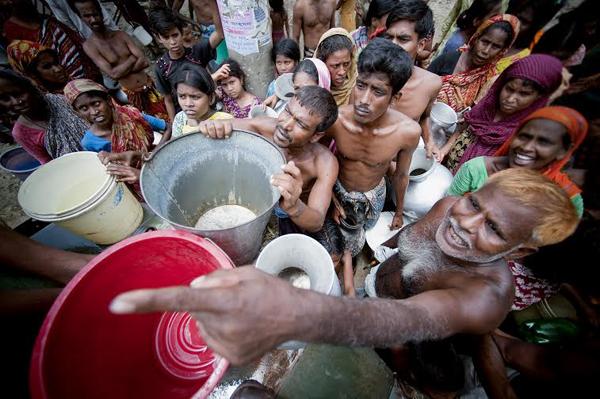 NIL
NIL
Water Wars: An empty cup
Life without water is unimaginable. But its availability, taken for granted, is in a crisis. The looming shortage has the potential to create conflicts among regions and communities in the near future. The recent UN International Conference on Water and Sustainability in Zaragoza, Spain, was a wake-up call to the problem. Ranjita Biswas reports
The older generation in India would remember famous magician P.C. Sorcar beginning his show with the item “Water of India.” As the audience watched mesmerised, he poured water from a small pot intermittently, symbolizing great rivers of the country; yet the water never seemed to be in short supply even after pouring several times.
There is a subtext to the act if you will: that water is so essential to our lives that rivers are regarded as holy in India; they keep the valleys fertile, give food and sustain the people.
But now water is in a crisis, so to say, as the availability of fresh water to sustain livelihood is increasingly getting scarce. This could seem an oxymoron when many regions in the world have been facing intense flooding, and unseasonably too. But then many regions also go ’water-less’; people lack safe drinking water, get sick drinking polluted water, children lose their lives, and people have to migrate as valleys go barren for lack of adequate water for cultivation.
These problems, and related aspects of water like sanitation, hygiene, to name a few, were the focus of discussion at the UN-Water Conference "Water and Sustainable development: From Vision to Action” held in Zaragoza in Spain recently.
The UN’s International Decade for Action ‘Ẃater for Life’ (2005-2015) draws to a close this year.
Experts and environmentalists have been warning for some time that water would be the next focal point of conflict with an unprecedented global impact. But it is seldom paid attention to by people in general. “Water security is a tricky question. People understand food security or energy security, but water security is more abstract. It’s given as God-given, and so it’s free,” observed Joakim Harlin, senior water advisor, United Nations Development Programme (UNDP) at the conference.
Figures tell
But that state of bliss can be shattered by some of the statistics available.
Worldwide, around 2.2 million people die each year from diarrhea, mostly children under the age of five in developing countries; an estimated 748 billion people do not have safe drinking water; 2.5 billion people lack access to improved sanitation i.e. more than 35 per cent of the world’s population; two thirds of the world’s population will live in water-stressed countries by 2025 if the current pattern of consumption continues. Water shortage has been identified by industry, government, academia and civil society as one of the top three global risks today.
Meanwhile, the urban population in developing countries will grow dramatically, generating demand well beyond the capacity of already inadequate water supply and sanitation infrastructure and services. According to the UN World Water Development Report, by 2050, at least one in four people is likely to live in a country affected by chronic or recurring shortages of freshwater.
As for India, the World Health Organisation estimates that 97 million Indians lack access to safe water, second only to China. As per the Ministry of Water Resources, India has 18 per cent of the world's population but has only 4 per cent of total usable water resources.
Women and water
In India, women still have to walk miles to fetch drinking water for home use in arid zones like Gujarat, Rajasthan, Haryana, etc. Women have to take this chore by default in a largely patriarchal society.
Research has shown that an average woman in rural India walks more than 15 km a day to bring home potable water.
But is it only a case in India? In many developing countries, the story is the same. Says Eliza P. Mngale, advisor , Tegemeo Women Group, Tanzania, which works for sustainable use of water: “In our village, fetching water is a woman’s job; even if tired they have to do it. And men don’t help.”
Finding that women and children suffered the most, and children even lost school hours, the women in her village and around formed this group and launched a water and sanitation project with seed money from an NGO, Women for Water Partnership and now enjoy freedom from the chore. “Water is the new energy. It’s empowerment through water sustainability for us,” she says.
Considering the crucial factor of women vis-a vis water, during the water decade, issues like women and children’s access to water, women’s vulnerability in countries also got included in the UN agenda on water and sustainability.
Involving the civil society in water management has paid rich dividends in countries like Brazil, Portugal etc., as was revealed during the conference.
Another initiative is to involve youth in the water campaign. And why not? As Ntiokam Divine, country representative for Youth Engagement in Agricultural Research for Development, Cameroon says: “We are the next generation. If we don’t understand the problem, if we don’t get involved, who will carry along the work next?”
Indeed, the need for coming together by various agencies to avert, and be prepared for, this area of concern in the environment scenario cannot be overstated, experts say. Coming on board will, of course, not a cake-walk. Even within the circle of policy makers, the academia or lawyers who specialise on water issues are somewhat kept outside the realm. Joan B. Rose of the Michigan State University, feels that the academia has an important role to play in tackling this global problem and it is high time to explore how to make science more relevant in water management programmes.
In 2014, the UN Open Working Group proposed a Sustainable Development Goal (SDG) to ensure availability and sustainable management of water and sanitation for all.
As the UN Water Decade comes to a close, now is a time to look beyond 2015, and go forward to bring the universal water goal to a reality, conveners headed by Josephina Maestu, director UN-Water Decade Programme on Advocacy and Communication, reminded at the conclusion of the conference.
The decade of ‘Water for life’ culminates in New Delhi on 22 March, 2015, on the World Water Day.
UN Photos
Top Headlines
-
Environment
Indi Setu: Wildlife on the Brink: Can We Rewild a Warming World?
October 25, 2025
-
Environment
SonaSPEED motors power NASAISRO synthetic aperture radar mission
August 01, 2025
-
Environment
How green is my city
July 01, 2025
-
Environment
India's River Dolphin: Clear And Present Danger
May 28, 2025
-
Environment
South Kashmir The costs of coexisting with predatory wildlife
May 12, 2025
-
Environment
Sariska Tiger Reserve: A maharani recognised
May 02, 2025
-
Environment
Arunachal Pradesh: Retracing a century-old biodiversity in Siang Valley
April 04, 2025
-
Environment
Toxic air and smog choke Delhi as experts at COP29 in Baku warn how dragging feet on fossil fuel reduction can cause catastrophe
November 19, 2024
-
Environment
The last feral horses of India
November 11, 2024
-
Environment
Indian savannas: New remote sensing study spotlights misclassification and flawed tree-planting
September 16, 2024

